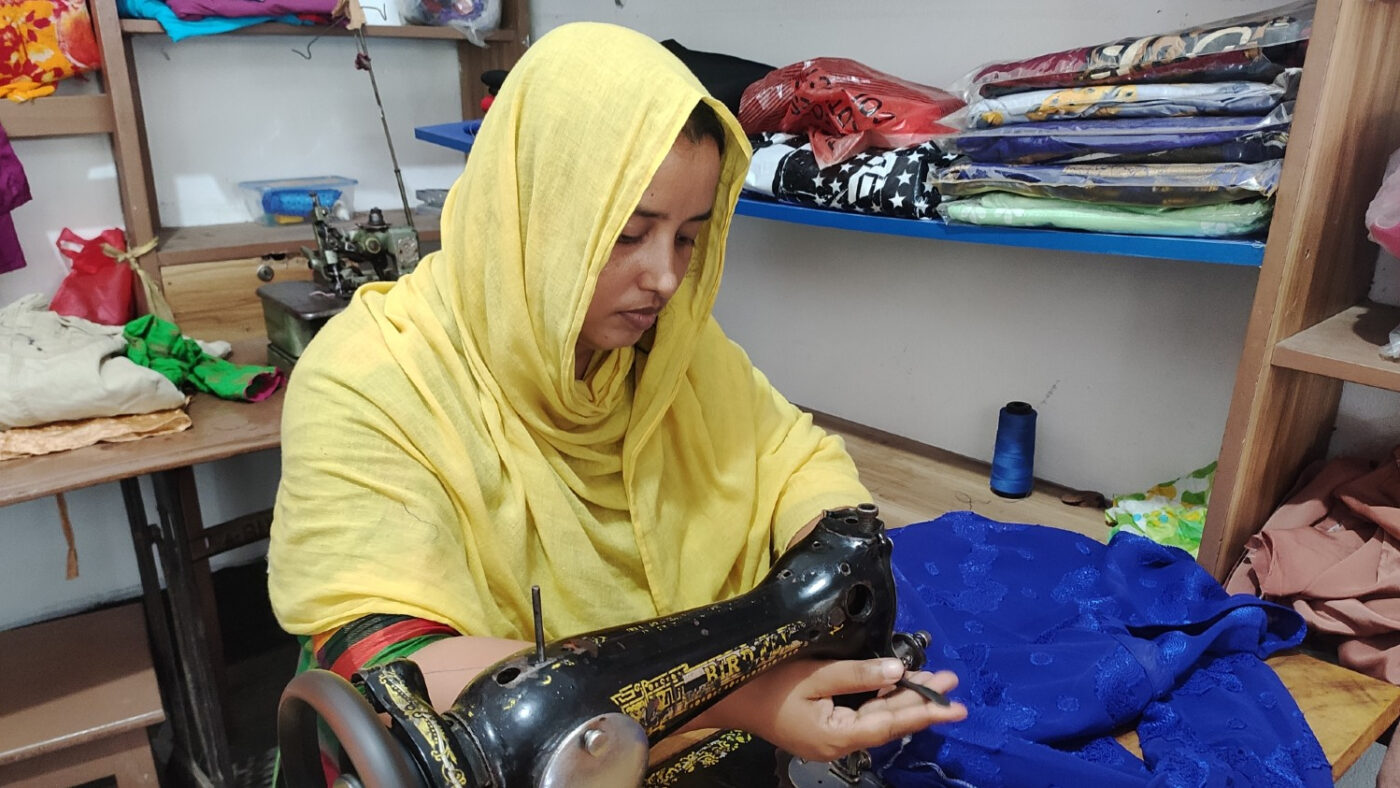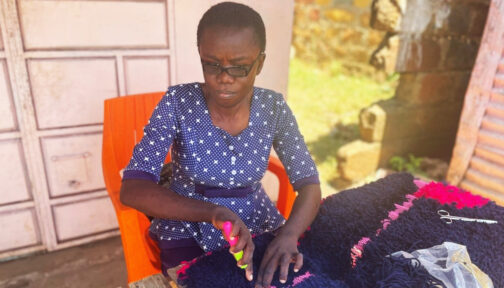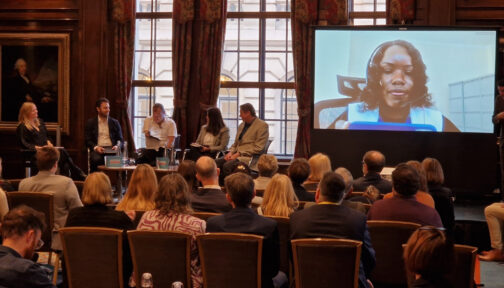As part of its work to improve how partners approach disability-inclusive programming, Inclusive Futures has interviewed three of our partners about how they’re putting what they’ve learned into practice.
Under Inclusive Futures, BRAC supported 1,900 people living in extreme poverty in northern Uganda, including more than 330 people with disabilities, with livelihoods and income generation coaching, and helped them to establish village savings associations and cash transfers. It also adapted its flagship vocational training and youth employment (STAR) programme to support young women and men with disabilities to overcome barriers to decent employment in the informal sector in Bangladesh.
Ankhi Mahbuba is a programme quality manager for BRAC. She supports the organisation’s poverty reduction programmes in Uganda, Tanzania, and Afghanistan.
Shammah Arinaitwe is project coordinator for BRAC’s disability inclusive poverty reduction programme in Uganda. She was involved in project design and uptake of learning around integrating disability inclusion into BRAC’s other livelihoods work.
Tasmiah Rahman is associate director for BRAC’s skills development programme. Her department oversees the work and disability-inclusive adaptations made to the STAR programme.
BRAC
BRAC is the largest non-governmental development organisation in the world. Through economic and social programmes, it empowers people and communities in situations of poverty and social injustice to realise their potential.
About BRAC
How would you describe the impact being part of Inclusive Futures has had on your work?
Tasmiah: BRAC is one of the largest non-governmental organisations in the world, working not only in Bangladesh but in many countries in Africa and Asia. Disability inclusion is one of our core priorities.
When we started working on Inclusive Futures, we needed to carry out foundational work to sensitise staff on disability inclusion, to set targets to include a certain percentage of people with disabilities in our projects, and also to put aside specific budget to support people with disabilities to take part in our projects.
How has BRAC embedded disability inclusion in its work over the past four years?
Tasmiah: STAR is a flagship programme within BRAC, which has been running for 10 years. It’s an apprenticeship-based training programme that supports young people with little or no education to get the training they need to get decent jobs. When we started working on Inclusive Futures, we wanted to understand how to include people with disabilities within this mainstream programme.
We wanted to find out how we could target people with disabilities better. What reasonable accommodation should be put in place in market spaces so young people are able to work somewhere where they feel safe and that their needs are met? It was also very important for us to work closely with government to deliver long-term benefits for young people with disabilities. For example, we developed easy read training modules with fewer words and more pictures. Bangladesh’s Technical Education Board and National Skills Development Authority has since accredited these training modules for use as part of the government’s national training curriculum.
Hiring people with disabilities to work on projects helped us to see what more we needed to do to make our work accessible for people with disabilities. We hired disability inclusion facilitators, who supported learners with disabilities and their families under the STAR programme. As a result, the attitudes of other BRAC staff members changed, as they realised that their colleagues’ disabilities did not affect their ability to do their work.
Shammah: We can’t talk about inclusive programming if the staffing is not inclusive. We now encourage people with disabilities to apply on all of our job adverts and provide reasonable accommodation during interviews. In fact, almost 17 per cent of staff who worked on the Inclusive Futures project in Uganda had some kind of disability. Since the project ended, almost 90 per cent have remained within the organisation.
As an organisation, we’ve learned that people with disabilities can work well if we put in place reasonable accommodation to ensure they can perform to the best of their abilities.
A key part of Inclusive Futures is working in a consortium. How has BRAC learned or benefited from other partners who have more experience of working on disability inclusion?
Shammah: Working with Humanity and Inclusion as technical experts in disability inclusion allowed our team to take on a lot of learning about how to actively engage people with disabilities, ensure the environments they are living in are adapted to their needs, and support them to access the livelihoods they want.
Tasmiah: We learned a lot from our consortium partners. Light for the World produced a Disability Inclusion Score Card, which we use to understand where strengths and weaknesses are, how we can better design our projects, and how we can better reach people with disabilities. When we raise funds, we now ensure that we include people with disabilities among our target groups and make sure that we allocate budget to support people with disabilities to take part equitably in our projects.
Inclusive Futures also works in partnership with organisations of people with disabilities (OPDs). What has BRAC learned from working with OPDs?
Ankhi: We have programmes in 36 districts of Bangladesh, so we tried to partner with more than one local OPD in those areas to leverage their support in reaching out to people with disabilities in those districts. In Uganda, we partnered with one umbrella OPD, the National Union of Women with Disabilities of Uganda. As part of this partnership, we worked together to advocate for the rights of women and girls disabilities to fight injustice and violence.
Shammah: What we’ve learned from working with OPDs is that they have very local, grassroots knowledge of the challenges that people with disabilities in their regions face and what the best ways of addressing them are. Through the umbrella OPDs, they also have the structures needed to advocate for the rights of people with disabilities, not just at a district level but at a national level too. What we’ve learned about working with OPDs in Bangladesh and Uganda, is now informing our work in Tanzania.
Watch the video below to learn more about the BRAC-led project in northern Uganda.
“When we raise funds, we make sure we allocate budget to support people with disabilities to take part equitably in our projects.”
How will BRAC implement disability-inclusive practices in its programmes beyond Inclusive Futures programming?
Tasmiah: We want to continue to use what we’ve learned from the disability-inclusive STAR programme to deliver projects, which are more inclusive of people with disabilities. This includes sharing the learnings with our staff and embedding them into our training programmes.
Shammah: The disability inclusive graduation project set a good precedent – not just for the staff that were working with the project, but for all of our work in Uganda. Part of that is making sure that data we are collecting for reporting is disability-inclusive, but also in our targeting processes, that we make sure we are targeting people using the Washington Group questions. We’re making sure that we disaggregate data by disability, and if we can go even further than that with types [of disability], and of course, by gender. Our reports include a section on disability inclusion so that we know how, we are performing in the various components of the work we are doing.
In this project, instead of using the traditional selection process that we use for graduation, we used household surveys instead, to speak to people with disabilities directly and identify what barriers were preventing them from taking part in the project. We found that unless we visited people with disabilities in their households, a family member or caregiver would come to represent them if the outreach was done at a community level.
Our original target was to have 15 per cent of our total participants being people with disabilities. Using this process, we ended up with 24.8 per cent of the total number of participants being people with disabilities. So this was a success and we’re now using this process as part of our ultra-poor graduation project in Tanzania.
Read the learning report
A summary of BRAC's learnings from adapting its skills development programme to be inclusive of young people with disabilities.
Read the reportHow is BRAC making changes to its internal policies and practices?
Tasmiah: In 2021, BRAC published a Disability Inclusion Strategy, setting out our intention to mainstream disability inclusion within the organisation’s work. In 2022, we also set up a specific unit focusing on disability.
Shammah: Disability inclusion is a journey, and it takes time. As part of the project in Uganda, we had to assess how our organisation was becoming more inclusive. We had a lot of accessibility audits and then had to make adjustments to make sure our offices were accessible. Ramps and handrails have been built in the office to help people walk up to a certain distance, which is good. Depending on funding, this will be extended to where the projects are being delivered, in the field offices.
If you look at BRAC’s staff, not only those who worked on the disability-inclusive ultra-poor graduation project, but across the board, it’s becoming more inclusive. These are small steps, that will go a long way to ensuring that disability inclusion becomes an inbuilt culture.
We also have a policy on safeguarding children, older people, and people with disabilities.
What are the next steps in BRAC’s disability inclusion journey?
Ankhi: Even though the project in Uganda was the first disability-inclusive graduation programme within the BRAC universe, BRAC is really planning to mainstream disability inclusion into its regular ultra-poor graduation programme.
For example, in Tanzania, we are trying to replicate and scale what we learned in Uganda. Thanks to what we learned through our partnership with HI under Inclusive Futures, we’re confident that we can carry out all the inclusion activities by ourselves.
Shammah: BRAC’s founder is quoted as saying: “Small is beautiful, but it’s absolutely necessary to bring it to scale.” The question is, how do you reach even more people?
In Uganda, we are working on a new project funded by another donor, which is focused on two generations within the same household, by focusing on both early childhood development and livelihoods. We’re using the Child Functioning Module to assess disability prevalence among children in our outreach and have built early childhood development centres that are accessible for children with disabilities.
Seeing how disability inclusion can be mainstreamed in ongoing or upcoming projects is one way to ensure that disability-inclusive development reaches the scale that is required.
“Thanks to what we learned, we’re confident we can carry out all the inclusion activities by ourselves.”
Do you know how to put disability inclusion into practice?
Take the Big Inclusion QuizMore news and opinions

Global Disability Summit 2025: Closing the gap between disability inclusion and development
Inclusive Futures is attending the summit in Berlin on 2-3 April. Visit our booth or attend our panel event to connect with us and learn more about our programme insights.

Sense International wins prestigious Zero Project award for its work with entrepreneurs with disabilities
Sense International has won a 2025 Zero Project Award for empowering individuals with deafblindness and complex disabilities in Kenya to build successful businesses and achieve financial independence.

Driving change: launching the six principles for inclusive development
Inclusive Futures and the UK Foreign, Commonwealth & Development Office marked International Day of People with Disabilities by jointly hosting an event to launch the six principles for inclusive development.
Sign up to Inclusive Futures emails today
Sign up to Inclusive Futures emails today
Want to hear more from Inclusive Futures? Sign up to receive the latest research from our programmes and resources to help make your work inclusive of people with disabilities.
For more information see our privacy policy
